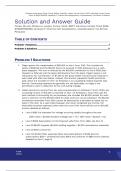Solution and Answer Guide: Young, Nellen, Persellin, Lassar, Cuccia, Cripe, SWFT Individual Income Taxes
2024, 9780357900550; Appendix F: Practice Set Assignments—Comprehensive Tax Return Problems
Solution and Answer Guide
YOUNG, NELLEN, PERSELLIN, LASSAR, CUCCIA , CRIPE, SWFT INDIVIDUAL INCOME TAXES 2024,
9780357900550; APPENDIX F: PRACTICE SET ASSIGNMENTS—COMPREHENSIVE TAX RETURN
PROBLEMS
TABLE OF CONTENTS
Problem 1 Solutions .............................................................................................................1
Problem 2 Solutions ........................................................................................................... 5
PROBLEM 1 SOLUTIONS
1. Diego reports his compensation of $85,000 on line 1 Form 1040. This includes his
salary of $98,000 and the $6,000 bonus he received in 2022 (because he is a cash-
basis taxpayer). This sum is reduced by the $19,000 contribution to his § 401(k) plan
(taxation is deferred until he takes distributions from the plan). Diego’s salary is not
reduced by his “contribution” of $7,200 to the group health insurance plan because it
was made with after-tax dollars. Instead, this amount represents health premiums
paid, which are included on line 1 of Schedule A as a qualifying medical expense (see
item 9). Commuting expenses are generally not tax deductible, so Diego is not
permitted to claim a deduction for his commuting mileage.
2. Isabel reports her income from her sole proprietorship on Schedule C (Form 1040). Her
consulting income of $72,000 is reported on Part I of Schedule C. Since she uses the
cash method of accounting for tax purposes, she includes the $3,000 receipt for work
done in 2021 but not the $5,000 billed for 2022 work but not yet collected. The $6,400
uncollected receivable from 2020 cannot be deducted as a bad debt as Isabel has no
basis in the item. As a cash-basis taxpayer, she never recognized any income. Her
deductible business expenses (other than the cost of her home office) sum to $11,095
and are detailed as follows:
• Line 9 $569 Car expenses for mileage occurring ratably throughout the year
[(940 miles × $0.585 standard mileage rate × ½) + (940 miles × $0.625 × ½)]
• Line 13 $800 Depreciation on the fireproof safe (from Form 4562, see item 3)
• Line 22 $8,000 Supplies ($4,800 drafting supplies + $3,200 reproduction materials)
• Line 23 $400 License fee
• Line 27a $1,350 Other expenses [dues and subscriptions of $490 (journal
subscriptions $250 + professional dues $240) and uniforms of $860 (work clothes);
detailed on Part V, page 2]
© 2024 . 1
website,
, Solution and Answer Guide: Young, Nellen, Persellin, Lassar, Cuccia, Cripe, SWFT Individual Income Taxes
2024, 9780357900550; Appendix F: Practice Set Assignments—Comprehensive Tax Return Problems
Isabel’s home office deduction of $4,304 is computed in item 3. Net profit from the
sole proprietorship sums to $56,577 on line 31, Schedule C (Form 1040).
Because Isabel is self-employed, she computes self-employment tax of $7,994 using
Schedule SE (Form 1040). Half of the self-employment tax of $3,997 is deductible on
line 15 of Schedule 1 (Form 1040).
Isabel qualifies for a qualified business income deduction of $10,516 [(net profit
$56,577 – deductible half of self-employment tax $3,997) × 20%], which is computed
on Form 8895 and reported on line 13 of Form 1040.
3. Isabel computes the deduction for her home office on Form 8829. Computations in
Part I show that 12.5% of the home’s living area is devoted to business use (300 square
feet of office space compared to 2,400 square feet in the home).
Computations in Part II differentiate between direct costs (painting expense of $1,250
on line 20) and indirect costs associated with the home which need to be prorated.
Indirect costs include mortgage interest ($4,000 on line 10), real estate taxes ($4,100
on line 11), insurance ($3,200 on line 18), repairs and maintenance ($1,800 on line 20),
and utilities ($6,200 on line 21).
Depreciation on the home of $641 is computed in Part III on the prorated business-use
adjusted basis for the house of $25,000 ($200,000 × 12.5%) multiplied by 2.564%, the
MACRS depreciation rate for 39-year nonresidential real property for the recovery
period of 2–39 years.
The total home office deduction of $4,304 is reported on line 36 of Form 8829 as well
as on line 30 of Schedule C (Form 1040).
Isabel deducts the $800 spent on the file cabinet by electing § 179 expensing. This
election is made by completing Form 4562 Part I for this acquisition. The deduction is
reported on line 13 of Schedule C (Form 1040).
4. Isabel’s exchange of the Ector County property for the McLennan County property
qualifies as a like-kind exchange. She reports this transaction on Form 8824.
Information about the exchange is reported in Part I of the form. The realized gain,
recognized gain, and basis in the like-kind property received are reported in Part III.
Isabel’s basis in the Ector County property is its fair market value when her uncle
passed away. Isabel must recognize a gain of $10,000 on the exchange, the lesser of
the cash received or the realized gain of $160,000. This recognized gain is reported on
line 23 of Form 8824.
5. The installment sale method of accounting generally applies to gains on dispositions of
property if the seller receives at least one part of the purchase price in a year
following the year of sale. Under this method of accounting, recognition of the realized
gain occurs when installment payments are received. Installment sales are reported on
Form 6252. The gross profit from the sale is computed in Part I. Isabel’s $30,000 basis
in the land was the fair market value of the property when her uncle died. Isabel’s
gross profit percentage from the sale is computed in Part II to be 75% ($90,000 ÷
$120,000), which translates into a gain of $15,000 on the $20,000 installment collected
this year. This recognized gain is reported on line 24 of Form 6252.
© 2024 . 2
website,




